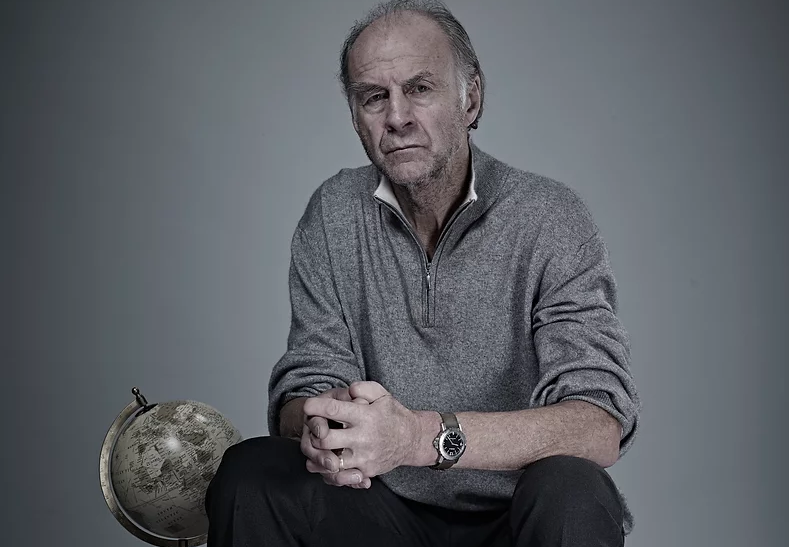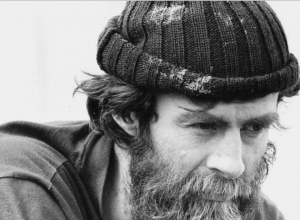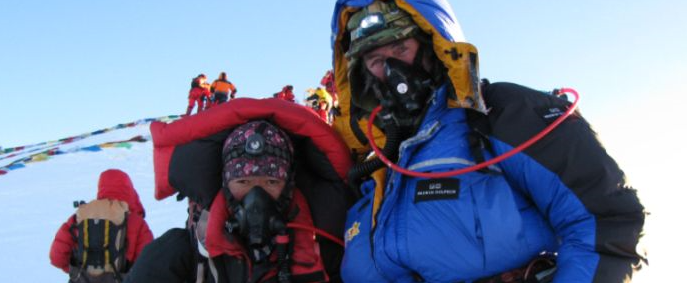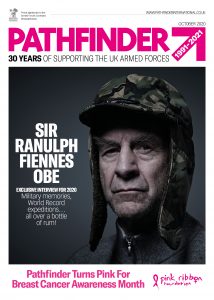Military Muscle and Pathfinder International were delighted to publish an exclusive for 2020 and a rare interview with legendary explorer, Sir Ranulph Fiennes OBE. The first part detailing Sir Ranulph’s military career can be found earlier in the magazine and in previous days online. Here, editor Mal Robinson talks to Sir Ranulph about his first expedition and his travel conquests since…

“We studied polar records because if you go for breaking records this will interest the media and my wife found that most of the Polar records as there are only two Poles had already been broken by the Norwegians and to us we didn’t use the word rivals, we called them “enemy”” muses Sir Ranulph on starting out in the world of expeditions.
“We found that they (the Norwegians) had broken all of the Polar records basically apart from one which they had failed dismally and that was to do the first circumference Polar journey around earth. People had been round horizontally like Christopher Columbus, but nobody had ever done the 52,000-mile journey around earth vertically crossing both Poles without any air support back at a time when we are talking about the 1970’s when there were no Polar satellites, no GPS or sat phone, using all the Scott/Shackleton stuff, it hadn’t changed since then…and nobody had done it.”
Sir Ranulph was of course talking about his first expedition which was the Transglobe Expedition which took place from 1979 to 1982, when he and fellow members of 21 SAS (Oliver Shepard and Charles R Burton) trekked around the world on its polar axis, using surface transport only. No one has ever done the route since. Sir Ranulph continues his story on the mammoth prep behind the trip.
“We looked at it very carefully and to cut a long story short, we realised people like Shackleton had the support of the Royal Navy, we wouldn’t have that, but what we did get was the support of the Army because I discovered that at the SAS headquarters in London, they were giving up some of the barrack space out there. And so, I went to the SAS headquarters and told them the idea of the first vertical journey around Earth without air support and they said “we really approve of that, but we don’t approve of you!”
They said “we know what you did with the Regiment and got thrown out the regular Regiment” and I said “yeah but that was seven years ago and I’ve matured since then!” and so they gave us room in the barracks to organise this expedition and get sponsorship.
We would need a Twin Otter Ski Plane to drop parachutes, but we’d never fly one inch of the journey but would need to drop pre fab huts in Antarctica in the middle of nowhere and you just don’t get that very easily.

It took 7 years working full time (to set up the expedition) and our only pay was from the Territorial Army. I joined 21SAS and so did the other people we selected to come on the expedition. We needed two others of the right calibre and Ginny (Sir Ranulph’s wife) would join the Territorial Hammersmith Royal Signals to become an expert at Morse Code, frequency prediction and antenna theory. And in those 7 years we got 1900 sponsors!”
Sir Ranulph continues…
“So Shackleton was supported by the navy and we were supported the whole way through by the SAS with a bit of help from the Sultan of Oman and that was 7 years work on TA pay and then a three-year expedition non-stop around the world without flying and that was the first of many expeditions that we did.
I must mention that the SAS only agreed to be the supporters of the expedition if nominally they put in charge of the whole thing, the bloke who had thrown me out of the regular SAS!”
Was his first taste of expedition life the stand out expedition for Sir Ranulph?
“The first one was wonderful to complete after 7 years of unpaid work and 3 years doing it and a year paying a few things back. It was 11 years of my life, 11 years of Ginny’s life, nearly, nearly failed at the last hurdle which was getting from the North Pole, three months floating on a bit of ice towards Russia, that was big problems.
Out of all the fifty years of expeditions I would say that the most problematic one was trying to cross the continent Antarctica without any form of support which had never been done.
This route was planned by Shackleton (years prior) but he would be using dogs, which could eat each other and then they could eat their last dogs. We had to carry 500lbs on the sledges which is 180lbs heavier than any previous land haul, but luckily my colleague at that time Dr Michael Stroud now Professor, was and I think still is Britain’s senior expert in stress nutrition and calories and it was a question of not dying of starvation mathematically over a certain distance towing a certain weight.”
I put it to Sir Ranulph whom has also conquered several mountains including Mount Everest and is known for his plethora of published books, what is more challenging a polar trek, climbing a mountain or writing a book? Sir Ranulph as ever diplomatically answering it as if none of them were daunting achievements, but then what is in his outstanding collection of merits?
“It depends on you! It depends on your ability. If you are good at writing, if you are physically strong, if in terms of mountains you are inclined to not get vertigo like I do, it depends on that to give the correct answer for that person.”
Was the fear of heights something that motivated Sir Ranulph?
“Ginny and I didn’t like vertical stuff. The Poles are all basically horizontal stuff as its so flat on the Arctic Ocean and once you get up to 12,000 feet of slow climbing its flat right the way across Antarctica so we didn’t have to worry with our vertigo problem but then eventually sadly Ginny died after 36 years of happy marriage. And I was so useless mentally after that and after a year of doing nothing I thought I should approach my real problems and I knew I was dead scared of heights so I thought “well, try Everest!”
On the third attempt I was an old age pensioner, the first old age pensioner to do it. I got to the top but only because I didn’t see any drops. For vertigo you need to see a dizzy drop below and on Everest I didn’t see any because if you look down there is a white shoulder and not a dizzy drop.
And so I did that one and that led to other ones and after Everest I still hadn’t lost my vertigo so a top climber Kenton Cool, a wonderful guide and his colleague Ian Parnell, they agreed to get rid of my vertigo on a thing much easier and closer to the UK to get to which was the north face of the Eiger in Switzerland and it took three days and nights to get up this cliff face and when I got to the top I realised with the two of them as my guides I did lose the vertigo but as soon as I couldn’t see them if they were out of sight, the vertigo came back. So I never did lose the vertigo and I stopped doing mountains after about ten years.”
Sir Ranulph climbed Mount Everest at the third attempt in 2009, after previous attempts to climb Earth’s tallest mountain failed. Once in 2008, bad weather prevented him from reaching the summit only 400 metres from the top and in 2005, when in a bid to become the oldest Briton to climb Everest (a title he eventually claimed) heart problems forced him back down the mountain after reaching the final stopping point of the ascent.

“In 2005 on the Tibetan side of Everest I got to 28,500 feet which was on the last night and within 300 metres from the summit ridge I had a big heart attack, an angina warning and I took the special pills I had with me and that saved my life I suppose.
I got down in three days and I promised never to do it again but by then I was realising the fundraising ability of these things and particularly if you are over a certain age and the public were really generous and we got up to £18.9M at the moment for various charities, which kept me going. The charity that we do all this for is chosen by the person who is sponsoring us. They choose which charity they want but it would normally be the British Heart Foundation, Marie Curie or Cancer Care, or someone like that.
Also on the expeditions we take scientists with us which is of huge benefit. In the nineties a Canadian magazine cited that none of my expeditions add scientific value so we took them to the high court who decided that we do do scientific work, we just don’t make a big song and dance about it and the scientists which we put in position for instance on the Transglobe 3-year expedition, the oceanographers on the trip, we had a 300-page scientific report so it wasn’t difficult to get the apology from the magazine.”
If book writing, polar trips, world records and climbing mountains (and more) wasn’t enough for Sir Ranulph, he has also launched his own rum – Sir Ranulph Fiennes’ Great British Rum as the man himself takes up the story…
“In the early Transglobe team, we had support on board a ship because obviously If you are going around the world vertically you have to get down and up the sea on the other side and we had a big wonderful ship’s crew of volunteers from nine different countries doing the ocean bits and on those ocean bits, Olly Shepard, an army bloke like the rest of us started a drinking club and rum was a great favourite and I particularly know on Polar expeditions, people like Shackleton, Scott and that lot, the Royal Navy, had rum and that’s how it all started.
The English distillers make our very special rum with certain flavours which happen to do with the expeditions over all of those years and so that’s unique to have.”
I add that I read somewhere, Sir Ranulph’s first drink after being abandoned on a block of floating ice and picked up by the support vessel was indeed a tot of rum as he didn’t like Champagne.
“That’s almost right, it was slightly different it was actually several tots of rum!” Sir Ranulph concurs.
Another story that does the rounds as is often so common with someone with the notoriety of Sir Ranulph was that one time he cut off his own fingertips. Was this true?
“Yes, on my left hand.
On one of the expeditions, which was a solo one stupidly, it was on the Arctic Ocean and it was minus 45 degrees at the time with the wind and I fell in and normally there’s two of you and one pulls the other one out.
I was very lucky to get out and so on. One hand had got badly frozen, I got into the tent and I managed to start the cooker and fire and I eventually got back to land, a place called Ward Hunt Island (an ice Island) and I managed on Morse Code to get through to the wonderful Canadian Twin Otter pilot to land in the dark and rescue me and got me to Montreal Hospital and they basically looked at the hand, all bloodied on my fingers and thumb. PPE said they wouldn’t pay for the amputation of the fingers out there; they would only do this in the UK.
And so I had to go back to the UK, which isn’t full of frostbite experts naturally and the finger surgeon who was very good with burnt fingers and not frostbitten ones said that he and any other surgeon would not cut the fingers off, not amputate them properly until five months after the trauma had occurred. This gives time for the bit which is not frostbitten about halfway down each finger to have five months of recovery.
Back home on Exmoor with Ginny, she said I was getting very irritable as every time the dead bits touched something on the tips of my fingers it was very, very painful. She by then was raising cattle and she would cut off with big clippers the Aberdeen Angus hooves every now and again and if you cut too near the live part of the hoof or blood you just move it further away into the dead bit and why not do that with my fingers she said.
So, we bought a Black and Decker workbench and a hacksaw and Ginny brought me cups of tea whilst I was doing it (cutting off the fingers). The thumb took two days because of the thicker bone and I couldn’t throw the finger ends away and so I still keep them in a mouse proof tin!” laughs the World Record holder explorer.
If Sir Ranulph had one tip of advice for people leaving the military what would it be?
“If they join the military and have a proper pension then that is well worth staying in for as I know to my cost.”
And finally did Sir Ranulph have any future plans to add to his list of worldly adventures? He answers as he begun, with the dry wit and a sense of fun…
“We have the same problem today our group, Mike Stroud and I as we did back then called The Norwegians so we don’t answer that question!”
Awards given to Sir Ranulph Fiennes OBE
French Parachute Wings 1968
Dhofar Campaign Medal 1968
Sultan of Oman’s Bravery Medal 1970
Man of the Year 1982
Livingstone Gold Medal Royal Scottish Geographical Soc 1983
Gold Medal NY Explorers Club 1984
Described by Guinness Book of Records as “The World’s Greatest Living Explorer” 1984
Fndr’s Medal RGS 1984
The Polar Medal 1984 with Bar 1995 by HM the Queen (his wife Ginnie was first female recipient)
ITV Award for Event of the Decade 1990
Explorers Club (Br Chapter) Millennium Award for Navigation 2000
Oldie of the Year Award 2004
Hon DSc Loughborough Univ
Hon Dr: UCE 1995, Univ of Portsmouth 2000, Univ of Glasgow 2002, Univ of Sheffield 2005. Abertay University (Dundee) 2007, Plymouth University 2011
Hon. Fellowship University of Glamorgan 2012
Hon. Director of Science University of Chester 2014
Some of the extraordinary huge challenges Sir Ranulph has been involved in include:
First to reach both Poles (with Charles Burton).
First to cross Antarctic and Arctic Ocean (with Charles Burton).
First to circumnavigate the world along its polar axis (with Charles Burton). ‘This 3-year, 52 000 mile odyssey took intricate planning, 1900 sponsors, a 52 person team to handle, complex communications, meticulous planning and iron determination mixed with flexibility. The circumnavigation has never been successfully repeated.
Led the first hovercraft expedition up the longest river in the world (the Nile) in 1968/1969.
Achieved world record for unsupported northerly polar travel in 1990.
Led the team that discovered the lost city of Ubar on the Yemeni border in 1992 (after seven previous search expeditions over a 26-year period).
Achieved world first in 1992/1993 by completing the first unsupported crossing of the Antarctic Continent (with Mike Stroud). This was the longest unsupported polar journey in history.
In 2003, only 3½ months after a massive heart attack, 3-day coma and double bypass, Ranulph Fiennes (with Mike Stroud) achieved the first 7x7x7 (Seven marathons in seven consecutive days on all seven continents).
March 2005 climbed Everest (Tibet-side) to within 300m of summit raising £2 million for the British Heart Foundations new research MRI scanner.
March 2007, Sir Ranulph climbed the North Face of the Eiger (with Kenton Cool and Ian Parnell) and raised £1.8 million for Marie Curie Cancer Care’s Delivering Choice Programme
Winner of ITV Greatest Britons 2007 Sport Award (beating the 2 other main nominees Lewis Hamilton and Joe Calzaghe)
May 2008, climbed Everest (Nepal-side) to within 400m from summit raising £2.5m for Marie Curie Cancer Care Delivering Choice Programme
Marie Curie 2008 ‘Above and Beyond Award’ Winner
Successfully summitted Everest May 2009 with Thundu Sherpa making a total for Marie Curie of over £6.2m. The oldest Briton ever to summit.
Becomes the oldest Briton, at the time, to complete the Marathon des Sables – the ‘toughest footrace on earth’ in aid of Marie Curie.
Read the entire issue for October HERE!

